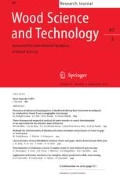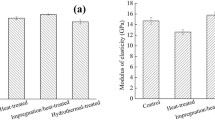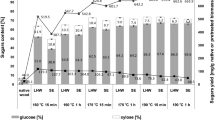Abstract
A new technique, micro-explosion, was used to pretreat fast-growing poplar wood and improve membrane porosity. Poplar lumber with a thickness of 20 mm was pretreated 10 times at pressures of 0.4, 0.6, 0.8 and 1.0 MPa. Subsequently, the test and control groups were dried in air to equilibrium moisture content. Several slices of 2–3 mm long at depths of 0, 2, 4, 6 and 8 mm were cut from the samples of both the pretreated and control groups for use in the scanning electron microscope. Numerous fine fractures were found at the weak parts of the cells, the pit membranes, following an instantaneous exhaust process which used pressurized air. With the increase in depth, the fractures became fewer and finer. Regardless of the fracture extent, at each level of pressure, the fractures could reach a depth of 8 mm. According to the diversity of fracture extent and location, the fractures could be classified into three main types: radial fracture opening along the pit membrane, ring fracture opening along the pit membrane and crush. The SEM photographs illustrated that the large capillary system of the micro-explosion-treated samples was widened, which could reduce resistance to moisture movement. Thus, micro-explosion treatment could be applied not only in the wood drying industry, but also to wood impregnation, as an effective method for improving impregnation efficiency.







Similar content being viewed by others
References
Carlquist S (1989) Adaptive wood anatomy of chaparral shrubs. The California chaparral: paradigms re-examined. Los Angeles Country Museum of Natural History Contributions, Los Angeles, pp 25–35
Choat B, Ball M, Luly J, Holtum J (2003) Pit membrane porosity and water stress-induced cavitation in four co-existing dry rainforest tree species. Plant Physiol 131(1):41–48
Choat B, Brodie TW, Cobb AR, Zwieniecki MA, Holbrook NM (2006) Direct measurements of intervessel pit membrane hydraulic resistance in two angiosperm tree species. Am J Bot 93(7):993–1000
Choong ET, Tesoro FO (1989) Relationship of capillary pressure and water saturation in wood. Wood Sci Technol 23(2):139–150
Fernando WJN, Low HC, Ahmad AL (2011) Dependence of the effective diffusion coefficient of moisture with thickness and temperature in convective drying of sliced materials: a study on slices of banana, cassava and pumpkin. J Food Eng 102(4):310–316
Haghi AK (2003) Thermal analysis of drying process: a theoretical approach. J Therm Anal Calorim 74(3):827–842
Kang CW, Kim GC, Park HJ, Lee NH, Wook-Kang Matsumura J (2010) Changes in permeability and sound absorption capability of yellow poplar wood by steam explosion treatment. J Fac Agric Kyushu Univ 55(2):327–332
Martin-Sampedro R, Revilla E, Villar JC, Eugenio ME (2014) Enhancement of enzymatic saccharification of Eucalyptus globulus: steam explosion versus steam treatment. Bioresour Technol 167:186–191
Pokki JP, Laakso VV, Tikka P, Aittamaa J (2010) Specific permeability of wood to water Part 1: longitudinal specific permeability of steamed, impregnated, and kraft-cooked wood. Ind Eng Chem Res 49(5):2144–2154
Ratnasingam J, Grohmann R, Scholz F (2014) Effects of pre-steaming on the drying quality of rubberwood. Eur J Wood Prod 72(1):135–137
Sheng ZW, Gao JH, Jin ZQ, Dai HF, Zheng LL, Wang BZ (2014) Effect of steam explosion on degumming efficiency and physicochemical characteristics of banana fiber. J Appl Polym Sci 131(16):40598. doi:10.1002/app.40598
Siau JF (1984) Transport processes in wood. Springer, Berlin, pp 25–30
Torgovnikov G, Vinden P (2009) High-intensity microwave wood modification for increasing permeability. For Prod J 59(4):84–92
Torgovnikov G, Vinden P (2010) Microwave wood modification technology and its applications. For Prod J 60(2):173–182
Vinden P, Torgovnikov G, Hann J (2011) Microwave modification of Radiata pine railway sleepers for preservative treatment. Eur J Wood Prod 69(2):271–279
Zhang YL, Cai LP (2006) Effects of steam explosion on wood appearance and structure of sub-alpine fir. Wood Sci Technol 40(5):427–436
Acknowledgments
The paper was supported by the Special Fund for Forest Scientific Research in the Public Welfare (201404502).
Author information
Authors and Affiliations
Corresponding author
Ethics declarations
Conflict of interest
The authors declare that they have no conflict of interest.
Rights and permissions
About this article
Cite this article
Ma, Q., Zhao, Z., Xu, M. et al. The pit membrane changes of micro-explosion-pretreated poplar. Wood Sci Technol 50, 1089–1099 (2016). https://doi.org/10.1007/s00226-016-0841-1
Received:
Published:
Issue Date:
DOI: https://doi.org/10.1007/s00226-016-0841-1




